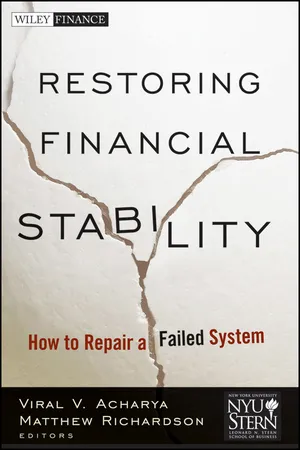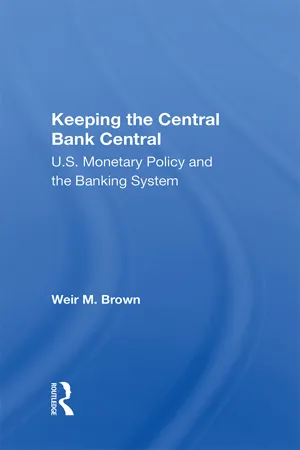Economics
Fed Balance Sheet
The Fed Balance Sheet is a financial statement that shows the assets and liabilities of the Federal Reserve System. It includes the amount of money in circulation, the reserves held by banks, and the securities held by the Fed. The balance sheet is used to monitor the Fed's monetary policy and its impact on the economy.
Written by Perlego with AI-assistance
Related key terms
Related key terms
1 of 4
Related key terms
1 of 3
3 Key excerpts on "Fed Balance Sheet"
- eBook - ePub
Restoring Financial Stability
How to Repair a Failed System
- Viral V. Acharya, Matthew P. Richardson, Viral V. Acharya, Matthew P. Richardson(Authors)
- 2009(Publication Date)
- Wiley(Publisher)
V.2 .) The new lending programs by the Federal Reserve and the Treasury have changed the face of U.S. monetary policy dramatically. In August 2007, the Fed had less than $900 billion in assets; as of year-end 2008, it has almost two and a half times as much. Deposit balances at the Fed held by depository institutions (DIs) are almost 50 times larger than they were in the summer of 2007. Loans to financial institutions have gone from $0.2 billion to over $150 billion.TABLE V.1 Consolidated Balance Sheet of the Federal Reserve System, August 1, 2007 ($ Amounts in Billions)Source: Federal Reserve Board Statistical Release H.4.1, August 2, 2007.When the Fed started its new lending programs in 2007, the effect of lending on reserves was offset by sales of Treasury securities. By the end of 2008, the portfolio of government bonds had dwindled, but the volume of lending continues to balloon. There has been an enormous expansion of aggregate liquidity in the financial system as the Fed attempts to mitigate the effects of deleveraging by financial institutions, the closing down of interbank lending, and the collapse of commercial paper markets.TABLE V.2 Consolidated Balance Sheet of the Federal Reserve System, January 14, 2009 ($ Amounts in Billions)Source: Federal Reserve Board Statistical Release H.4.1, January 15, 2009.This vastly expanded balance sheet will pose new challenges when the Fed decides to delever its balance sheet. It will not be a simple matter of increasing the federal funds rate when the economy recovers. The challenge will be to restructure the balance sheet in a timely fashion so that it doesn’t impair monetary policy objectives.Finally, a crucial policy question will need to be addressed: Which of the new facilities should be phased out and over what time table? Provision of lender of last resort support to systemically important nonbank financial institutions may make sense if these institutions become part of the regulatory and supervisory umbrella of the Fed. Provision of market making of last support (repos and/or purchases of illiquid assets in periods of market stress) may also make sense, as long as the moral hazard effects of such support are constrained by proper regulation and supervision of financial institutions in good times. - eBook - ePub
The Bank Credit Analysis Handbook
A Guide for Analysts, Bankers and Investors
- Jonathan Golin, Philippe Delhaise(Authors)
- 2013(Publication Date)
- Wiley(Publisher)
Chapter 5
Deconstructing a Bank’s Balance Sheet
[A ]typical bank’s balance sheet presents, on the face of it, an alarmingly precarious situation: its liabilities are mostly short term, but most of its assets are realizable only in the long term, and it is highly geared or “leveraged.” Depositors and other creditors must be persuaded that the whole pack of cards will not come crashing down at a moment’s notice.—Fitch IBCA1This book explores the creditworthiness of banks from several angles, many of them articulated around the balance sheet and, increasingly, around off-balance-sheet items. Bank financial statements are very complex. Readers may be familiar with general accounting rules, and this chapter will introduce them more specifically to the bank’s balance sheet—and its off-balance-sheet items. Inevitably, a number of concepts or definitions have to be discussed at this stage, while a more thorough analysis will be offered in later chapters, thereby introducing some degree of unavoidable duplication.The balance sheet, also known as the statement of condition or statement of resources records assets on one side and liabilities and equity on the other. The two sides must balance, hence the term. Some analysts, however, prefer to separate the liability side into equity—which for a bank is usually just a small fraction of the total—and actual liabilities toward third parties, as can be schematically seen in Exhibit 5.1 .EXHIBIT 5.1 The Balance SheetThe balance sheet merely captures a snapshot of the composition of a firm’s assets and the claims upon it at one moment in time—usually December 31 or the end of a quarter. Since it is a static picture, it does not say much about the company’s past performance or about its likely future. Hence, the balance sheet provides precious little information about the company’s ability to service debt on an ongoing basis. Of course, by comparing the firm’s balance sheets at various times, some inferences can be drawn about its debt servicing capacity - eBook - ePub
Keeping The Central Bank Central
U.S. Monetary Policy And The Banking System
- Weir B Brown(Author)
- 2019(Publication Date)
- Routledge(Publisher)
For these reasons, they point out, the Fed has to an increasing degree come to regard open-market dealing as its most effective control instrument. The infrequent and reluctant resort to a change in the discount rate and, especially, in the required reserve-ratios is noted; and the nearly exclusive use of open-market operations as the all-purpose tool is ascribed to its being the instrument of choice. 2 It should be added, however, that although the functional relationship between the level of money and credit and that of the reserve stock is sometimes not explicitly mentioned in referring to the policy mix, the role of the reserve mass as the ever-present anvil on which the hammer of open-market intervention carries out its work is recognized operationally. The Federal Reserve System, as the central bank of the United States, is charged with the responsibility of providing the economy with a safe, flexible, and efficient banking and monetary system. This has entailed helping to shape the structure of that system and monitoring to assure its smooth functioning. The Fed regularly performs, actively or passively, as a banker for banks; and, though fostering the articulation of healthy private financial markets, it has the known capacity to serve as lender of last resort. Thus, the Federal Reserve exercises very important episcopal tasks of its own within the institutional structure. It also, however, has a major share in the still-larger sphere of general economic policy by formulating and executing the monetary policy that influences, together with other forces, the economy's macroeconomic course. This obliges the Board and other Fed bodies to seek to assure that the rate of expansion in money and credit is adequate to the changing productive needs of the real economy, subject to the need to maintain price stability. There are problems of cyclical slumps or booms that complicate the longer-term aspects of devising monetary policies
Index pages curate the most relevant extracts from our library of academic textbooks. They’ve been created using an in-house natural language model (NLM), each adding context and meaning to key research topics.
Explore more topic indexes
Explore more topic indexes
1 of 6
Explore more topic indexes
1 of 4


